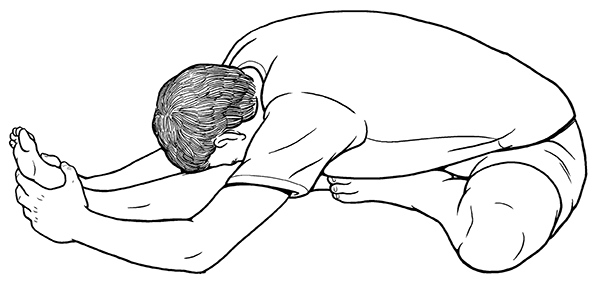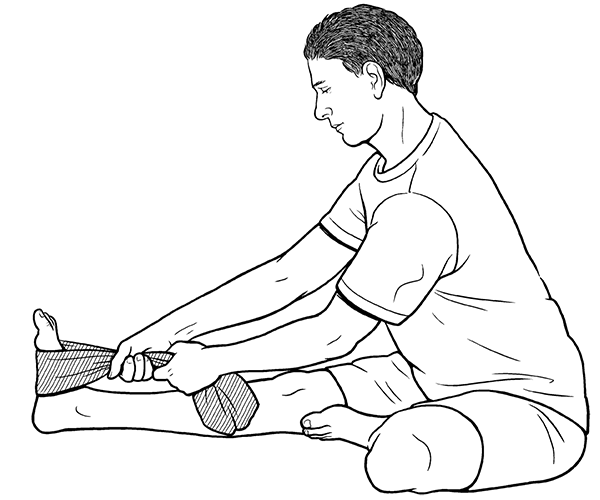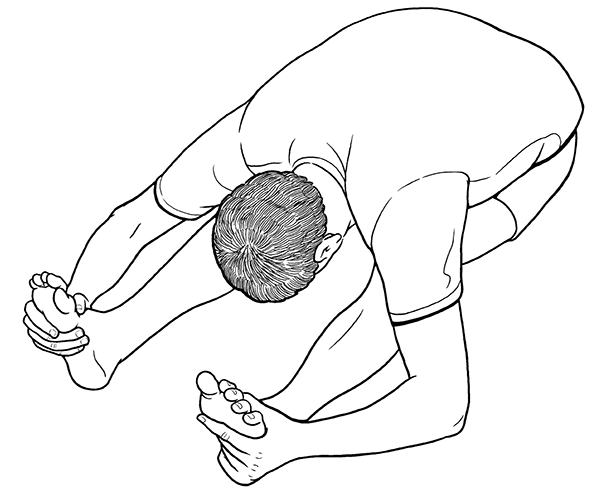Chinese Healing Exercises (9 page)
Read Chinese Healing Exercises Online
Authors: Steven Cardoza
Tags: #Taiji, #Qi Gong, #Daoist yoga, #Chinese Healing, #Health, #medicine, #remedy, #energy

Variations
Variation One:
If you're unable to reach your foot, you may use a belt or towel to wrap around the sole of your foot. Hold the belt or towel with both hands, as close to your foot as possible for you
(
Fig 2.6
),
and continue as directed above.
 Figure 2.5 (One-Leg Hamstring Stretch)
Figure 2.5 (One-Leg Hamstring Stretch)
 Figure 2.6 (One-Leg Hamstring Stretch)
Figure 2.6 (One-Leg Hamstring Stretch)
Your ultimate goal is to be able to lay your chest fully onto your leg, but this must be accomplished by relaxation and release, and never with any feeling of strain. It may take many weeks, months, or longer for you to be able to do that, and if you have been very tight for a very long time, that deep a stretch may not ever be possible for you. The important thing is to improve over time, and enjoy the benefits that occur along the way. When you reach your natural limit, whether laying your chest on your leg or not, stay in that stretch for approximately two minutes, but no longer than that, as then you can begin to overstretch your ligaments. The easiest and most beneficial way to time a two-minute stretch is to time the length of your comfortable inhale and exhale, and then simply count your breaths to the appropriate number. For example, if you can comfortably inhale and exhale in a fifteen-second cycle, four breaths per minute, then you'd hold your stretch for eight breaths. This method allows you to use your breath to deepen your relaxation the longer you hold the stretch.
Variation Two:
In some forms of Daoist Yoga, any increase in a stretch only occurs through release of tight or held muscles, not through actively using even the slightest force, such as carefully pulling on your foot as is otherwise done in this exercise. That release is accomplished by combining at least three factors. The first is your breath, which is directed to a tight muscle or region on an inhale, and the tension is released to whatever degree is possible on the exhale, leaving your body along with the breath. Numerous directed breaths can be done to facilitate this process. The second factor is the force of gravity. As you engage in any stretch, gravity will usually play a role in increasing the stretch. In this exercise, gravity will push on your torso as it lowers toward your leg. Feel its influence and allow it to open your body into a deeper stretch. The third factor is your mind. Some part of your mind must contact the tense, tight, or held muscle, and be used to soften and release that held tension. There is no physical effort involved in this aspect, and this is different than using your breath and gravity, though it may seem similar. Personal guidance by a teacher may be necessary for you to fully incorporate this release, but you won't harm yourself in any way by trying it if it appeals to you. In this variation, you may place your hands on the floor, on your lower leg, or grasp your foot, but you do not pull on your foot or leg at all. You can use this approach in the following exercise, and in any other stretch, often involving a forward bend, where gravity and breath may be used together along with mind.
4.Two-Leg Hamstring Stretch
This exercise should only be attempted once the One-Leg Hamstring Stretch can be done comfortably, regardless of how far you can lower your torso to your leg.
Purpose
Physical:
Stretches all the muscles at the back of the leg. While mainly targeting the hamstrings, it also stretches the calf muscles. Here the lower back is opened considerably more than it is in the one-leg stretch, and in a necessarily more balanced way. If your low back is particularly tight, as it is for many people, be prepared to feel more restriction there, which must be opened too in order to get the deepest hamstring stretch possible.
Energetic:
Stimulates qi flow through the Urinary Bladder meridian, which runs up the back of the legs, and helps resolve qi stagnation in that portion of that meridian. This benefits the functions of the bladder, and can help to improve most urinary tract problems. Because the low back is opened more, the Kidneys are both massaged and relaxed. The Kidneys and Urinary Bladder are a Yin-Yang organ pair; addressing them simultaneously in this exercise will mutually increase the benefit to both.
Techniques used
Stretching, Daoist Yoga, focused breathing.
Method
Sit on the floor with both legs extended in front of you, lightly touching, or spread up to a foot apart if necessary. Keep your back straight, not bent or bowed, although it will incline forward when you follow the next instructions. With both hands, grab your feet, and keep them held perpendicular to the ground, not tilted forward or splayed out to the sides. Take a comfortable deep breath in, and while slowly letting it out, gently pull on your feet and incline your upper body toward your legs. Do your best to keep your upper body directly aligned with your legs and not bent (curved or arched) forward.
Repeat the breath and increase the stretch on the exhale, further lowering your chest to
ward your legs
(
Fig 2.7
)
.
When you reach the place beyond which you can stretch no further, hold that stretch for five to ten slow, deep breaths, allowing yourself to relax into the stretch more with each exhalation. Then release your feet, place both hands at the sides of your knees or slightly higher, and use them to push yourself back to an upright seated position, so you won't strain your back. Repeat the stretch once or twice more.
Variation
Some very flexible people may have large bellies that interfere with being able to lay their chest on their legs. In that case, it's fine to spread your legs wider to allow more space for your belly
(
Fig 2.8
).
As in the One-Leg Hamstring Stretch, your ultimate goal is to be able to lay your chest fully onto your legs, but this must be accomplished by relaxation and release, never with any feeling of strain. It may take many weeks, months, or longer for you to be able to do that. When you reach your natural limit, whether you're able to lay your chest on your legs or not, stay in that stretch for approximately two minutes, but no longer than that, as then you can begin to overstretch your ligaments. When you're able to stretch, for two minutes, do only one of these stretches in any practice session.
 Figure 2.7 (Two-Leg Hamstring Stretch)
Figure 2.7 (Two-Leg Hamstring Stretch)
 Figure 2.8 (Two-Leg Hamstring Stretch)
Figure 2.8 (Two-Leg Hamstring Stretch)
5. Seated Split
Purpose
Physical:
Stretches the leg adductors (the inner leg). There is also a stretch at the back of the legs (hamstrings and calves) and the low back, but since you've already opened those regions in the previous exercises, you may not notice much of a stretch there. This will also stretch the muscles at the inner knee, and spread the perineum.
Energetic:
Engages and activates the Leg Yin meridians, continuing and deepening the benefits of the second paidagong exercise in this section. Those include the Liver, Spleen, and Kidney meridians. The more qi stagnation and obstruction you were able to release in that practice, the easier it will be to get deeper in this stretch, and the sooner you will be able to release any associated muscle tension.
Techniques used
Stretching, Daoist Yoga, focused breathing.
Method
Sit on the floor with both legs extended, spread as far apart as is comfortable, with the back of the knees very close to the ground without locking them, and feet perpendicular to the ground. Keep your back straight, not bent or bowed, although it will incline forward when you begin the stretch. If you are completely new to this type of stretch, begin by placing the palms of your hands on the floor in front of you, spread slightly wider than shoulder width apart. This is to give support both to your low back and your inner legs, both of which may feel strongly stretched in this exercise. Take a comfortable deep breath in, and while slowly exhaling, lower your torso straight forward, evenly between your legs, using your hands to help support the weight of your upper body. Do your best to keep your back straight and not bent (curved or arched) forward. Repeat the breath and increase the stretch on the exhale
(
Fig 2.9
).
When you reach the place beyond which you can stretch no further, hold that stretch for five to ten slow, deep breaths, allowing yourself to relax into the stretch more fully with each exhalation. Then use your hands to push yourself back to an upright seated position, so that you don't strain your back. Repeat the stretch once or twice more.
 Figure 2.9 (Seated Split)
Figure 2.9 (Seated Split)
 Figure 2.10 (Seated Split)
Figure 2.10 (Seated Split)